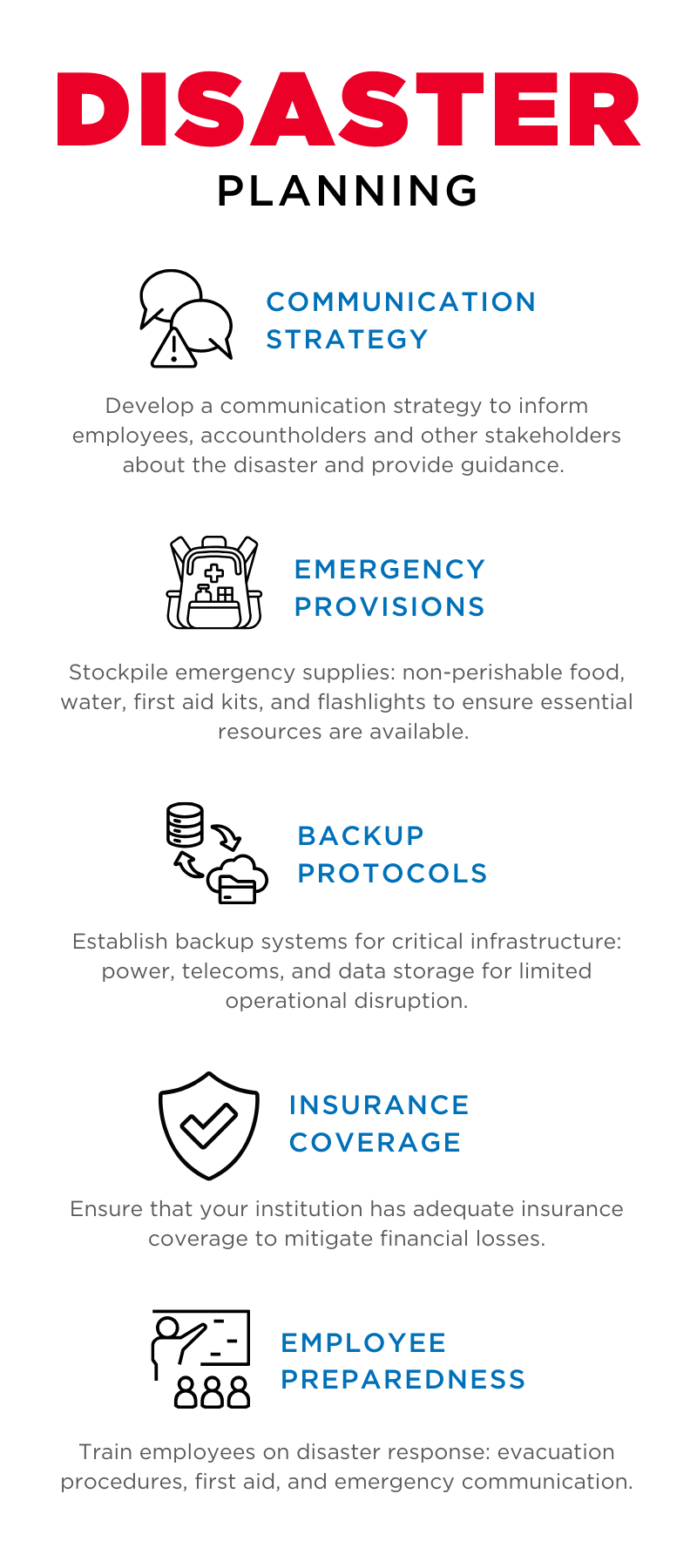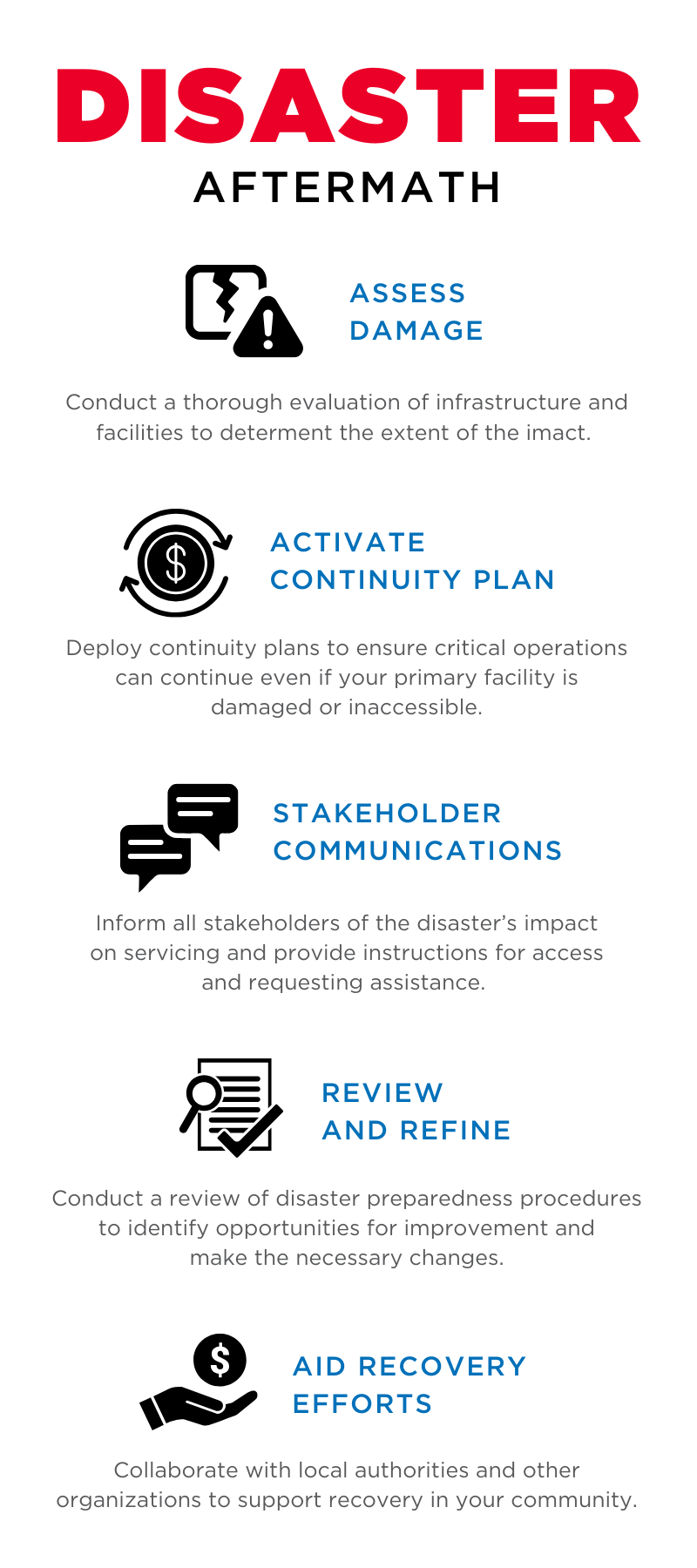Disaster recovery planning is a critical pillar of business continuity management. For financial institutions, disaster relief encompasses more than cleanup. A natural disaster may result in financial “cleanup” as well.
Hurricanes, tornadoes, or a blizzard may leave employees asking:
“Do I need to use PTO if my branch location is closed because of a storm?”
Borrowers and accountholders may be asking:
“Do I still need to make payments on a damaged vehicle/car?”
To help financial institutions consider how to respond to concerns like these, we’ve outlined disaster preparedness best practices.
Preparation is Key
While hoping you never have to activate your plan, you must feel confident in responding to a natural disaster that may hit your area and impact business operations. Here’s how to be prepared for any type of natural disaster:
- Conduct a risk assessment
Identify potential hazards that could affect your financial institution and those you serve. This includes identifying the likelihood and potential impact of natural disasters such as hurricanes, earthquakes, tornadoes, floods, and wildfires. - Develop a disaster response plan
Infrastructure destruction, as well as commodity effect and scarcity.
- Document and communicate post-disaster procedures

It is challenging to foresee the full scope of the economic effects that a significant natural disaster can cause. Typically, a disaster has a negative impact on the local economy, but it can also have repercussions beyond the affected area.
Most importantly, keep your accountholders concerns in mind. There are five categories of consumer concerns to keep in mind as you develop your recovery procedures and communications.
A recovery plan will get your business back up and running and strengthen your portfolio recovery activities too.
In the wake of a local disaster, your borrowers may face confusions about deferrals, upside down loans, etc.
5 Ways to Help Borrowers Recover
Rising defaults are a common challenge financial institutions face after a natural disaster. Borrowers may be uncertain about whether missed loan payments will be automatically deferred or placed on forbearance. They might also be confused about overdrawing their accounts or potential collection actions. Additionally, they could find themselves with an upside-down vehicle loan or become victims of charity scams.
Use this list to reduce confusion and help your borrowers recover financially after a natural disaster.
- Comunicate Financing Options for Total Vehicle Losses
Clearly explain financing options to borrowers who have experienced a total vehicle loss and may be dealing with an upside-down loan. Regularly inform them how their insurance coverage relates to the outstanding balance of their auto loan. - Monitor Fraudulent Activity
Encourage borrowers to monitor their accounts and credit reports for any signs of fraudulent activity. Advise them to contact their provider immediately if they notice any suspicious charges or issues. Ensure that all communications from third-party vendors clearly identify the financial institution and are specific to the issue to avoid confusion and skepticism. - Ensure Adequate Insurance on Collateral
Verify that your institution has sufficient insurance on collateral to mitigate financial losses from natural disasters. - Proactively Communicate Options for Deferrals or Forbearances
Clearly inform customers about their options for deferrals or forbearances and be transparent about your collection policies and any actions that may be taken in case of missed payments. By communicating openly, lenders can help alleviate confusion and stress for borrowers during difficult times. - Implement and Communicate Emergency Overdraft Limit Changes
Decide if you want to implement emergency overdraft limit changes during natural disasters and communicate these changes clearly to borrowers.
Being aware of the concerns borrowers may face can help them regain financial stability after a disaster. Financial institutions can play a crucial role in assisting their customers and communities through these challenging times by providing clarity on various financial issues that may arise. This requires a comprehensive preparedness plan.
Take these proactive steps to be prepared and assist your customers before, during, and after a disaster to help them regain financial stability.
Minimize the Impact
Natural disasters can have devastating consequences, but with proper preparation and a well-executed post-disaster protocol, these impacts can be minimized. By conducting a risk assessment, developing a comprehensive disaster preparedness plan, and taking swift action in the aftermath, you can protect your employees and borrowers. Remember: disaster preparedness is an ongoing process that requires regular review and revision to remain effective and relevant in the face of changing weather conditions.
